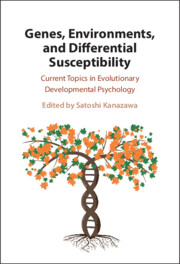 Genes, Environments, and Differential Susceptibility
Genes, Environments, and Differential Susceptibility Book contents
- Genes, Environments, and Differential Susceptibility
- Genes, Environments, and Differential Susceptibility
- Copyright page
- Contents
- Figures
- Tables
- Contributors
- Introduction
- Part I Historical Background and Theoretical Foundations of Jay Belsky’s Work in Evolutionary Developmental Psychology
- Part II Parent–Child Relations and Attachment
- Part III Life-Course Development from Prenatal Environment through Childhood to Adulthood
- Part IV Differential Susceptibility to Environmental Influences
- Chapter 9 Unequal Monks, Unequal Hoods?
- Chapter 10 Child Maltreatment and the Development of Multisystem Resilience
- Chapter 11 Differential Susceptibility and Its Usefulness for the Understanding of Crime and the Rehabilitation of Criminals
- Conclusion
- Afterword
- Biography of Jay Belsky
- Index
- References
Chapter 9 - Unequal Monks, Unequal Hoods?
A Call for Experiments on Genetic Differential Susceptibility
from Part IV - Differential Susceptibility to Environmental Influences
Published online by Cambridge University Press: 04 September 2025
- Genes, Environments, and Differential Susceptibility
- Genes, Environments, and Differential Susceptibility
- Copyright page
- Contents
- Figures
- Tables
- Contributors
- Introduction
- Part I Historical Background and Theoretical Foundations of Jay Belsky’s Work in Evolutionary Developmental Psychology
- Part II Parent–Child Relations and Attachment
- Part III Life-Course Development from Prenatal Environment through Childhood to Adulthood
- Part IV Differential Susceptibility to Environmental Influences
- Chapter 9 Unequal Monks, Unequal Hoods?
- Chapter 10 Child Maltreatment and the Development of Multisystem Resilience
- Chapter 11 Differential Susceptibility and Its Usefulness for the Understanding of Crime and the Rehabilitation of Criminals
- Conclusion
- Afterword
- Biography of Jay Belsky
- Index
- References
Summary
Belsky noted that for evolutionary-biological reasons, development may not follow a cumulative risk model. He theorized that ‘vulnerable’ children might actually be susceptible to environmental influences for better and for worse. Moreover, he argued that variation in susceptibility within the family would be evolutionarily advantageous for both parents and children. Stimulated by Belsky’s provocative thinking, and relying on randomized controlled trials that constitute the most stringent and powerful tests of the paradigm, we found meta-analytic support for (genetic) differential susceptibility. Examining the bold idea of within-family differential susceptibility, we included twins in our cohort-sequential randomized controlled trial and designed a series of experiments on mice. One of our mice studies revealed the expected crossover interaction. Heterozygous DRD4 mice who had grown up in an enriched environment licked and groomed their own offspring the most, while those who grew up in adverse circumstances showed the least licking and grooming. In humans, our experimental search for within-family differential susceptibility has not yet supported this bold conjecture. An explanation might be that the available polygenic scores for susceptibility were developed in the context of internalizing, not externalizing, problems. Susceptibility to environmental influences may be more domain specific (Belsky et al., 2022) than we originally thought.
Keywords
Information
- Type
- Chapter
- Information
- Genes, Environments, and Differential SusceptibilityCurrent Topics in Evolutionary Developmental Psychology, pp. 195 - 216Publisher: Cambridge University PressPrint publication year: 2025
References
Accessibility standard: WCAG 2.0 A
Why this information is here
This section outlines the accessibility features of this content - including support for screen readers, full keyboard navigation and high-contrast display options. This may not be relevant for you.Accessibility Information
Content Navigation
Allows you to navigate directly to chapters, sections, or non‐text items through a linked table of contents, reducing the need for extensive scrolling.
Provides an interactive index, letting you go straight to where a term or subject appears in the text without manual searching.
Reading Order & Textual Equivalents
You will encounter all content (including footnotes, captions, etc.) in a clear, sequential flow, making it easier to follow with assistive tools like screen readers.
You get concise descriptions (for images, charts, or media clips), ensuring you do not miss crucial information when visual or audio elements are not accessible.
You get more than just short alt text: you have comprehensive text equivalents, transcripts, captions, or audio descriptions for substantial non‐text content, which is especially helpful for complex visuals or multimedia.
Visual Accessibility
You will still understand key ideas or prompts without relying solely on colour, which is especially helpful if you have colour vision deficiencies.
You benefit from high‐contrast text, which improves legibility if you have low vision or if you are reading in less‐than‐ideal lighting conditions.